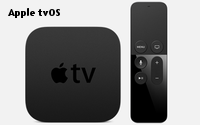
Okay, so Apple calls
it “tvOS,” but it’s based on its iOS operating system, and it is basically just another attempt by an operating system developer to muscle its way into television. Apple has tried
before. So have Google and Microsoft. All have failed. So will Apple’s tvOS. Here’s why? TV is not a technology, it’s an experience.
People use technology to
experience TV. Some technologies enhance the way we experience TV. They have given us greater control of when, where and why we watch it. They have given us greater choice and access to content. They
have improved the quality and stability of the signals we receive (most of the time) and have enhanced the resolution of what we experience when we receive them. But they are not television.
Ironically, HBO may have explained it best with their deliciously ironic tagline -- you know, “It’s not TV. It’s HBO” -- because HBO is genuinely a television
experience. You can call it a channel. You can call it a network. You can even call it a premium subscription service. Those are all industrial ways of describing business models, which aren’t
unimportant in terms of the viewer’s experience, but it is the experience that makes those models work -- or not.
Let’s stick with the HBO metaphor for a moment. When it
first came on the scene 1970s many people in the media industry weren’t sure what to make of it. But consumers did. It was a new way of experiencing television and when the earliest adopters of
the subscription service signed up for it they didn’t says I’m getting “cable TV,” they said, “I”m getting HBO.” In fact, for a while HBO was what many
consumers thought cable TV was.
But it was all about experiencing television in a way they couldn’t before. In the case of HBO, live premium sports and feature films that they
previously could only experience that way in theaters, was enough that they were willing to pay for it at a time when other forms of TV were basically still free to them.
So if you
ask me, HBO is TV. Apple is not. It’s just a conduit. Or, if you will, an interface. And what we’re increasingly learning from progression of technology is that there are -- and will
continue to be -- many interfaces for experiencing television.
But the purpose of any interface is to augment a human experience. And if I understand Apple’s new tvOS
correctly, there are a few things I don’t get. Like why the remote control. It’s become an inferior and unnecessary part of TV’s UI and that’s one that’s just waiting for
disintermediation. Developers have been trying to improve on it for years, and largely failed to get any real consumer adoption. So why isn’t Apple leveraging the most logical interface it has
for controlling TV experiences remotely? Its phones. I mean, why add another gadget that people are just going to lose in their couch cushion anyway. People don’t lose their iPhones in their
couch cushion, because they’re so anxious about being separated from it that they hardly ever put it down.
For the past couple of years, I’ve increasingly been using my
phone -- a Google Nexus 5 -- to control my TV viewing experience via its Chromecast application. It’s getting better and increasingly more seamless. Mainly I use it to watch over-the-top
television experiences, especially Netflix and, yes, HBO.
Ironically when my cable TV provider -- Cablevision’s “Optimum” service -- failed to deliver on my TV
viewing experience, HBO and my Google interface did.
My wife and I have been binge-ing “Game Of Thrones” over the summer and we were nearly caught up and went on
Optimum’s on-demand service to check out the two most recent episodes when lo and behold, they just weren’t there. After a momentary sense of WTF and disappointment, I picked up my phone,
clicked on my HBO Go app, initiated the episodes we wanted to watch, and Chromecasted the experience to our TV set.
The point isn’t about technology. I would have just as soon
accessed “Game Of Thrones” via my cable operator, but it failed me so I went to the next best technological option. People have been doing that for years to access the TV experiences they
wanted to have. We bent the rabbit ear antennas on our analog sets till we got the signal in range. We signed up for cable, satellite of telco service access. We got digital atenntas and receivers to
access digital over-the-air spectrum. We subscribed to Netflix, Hulu, Amazon and the ilk. (And if we were a Millennial, we probably hacked into what we wanted via some socially distributed
pirate platform). Or we downloaded apps like HBO Go.
The point is that an OS is not TV. It’s just another way of accessing it.